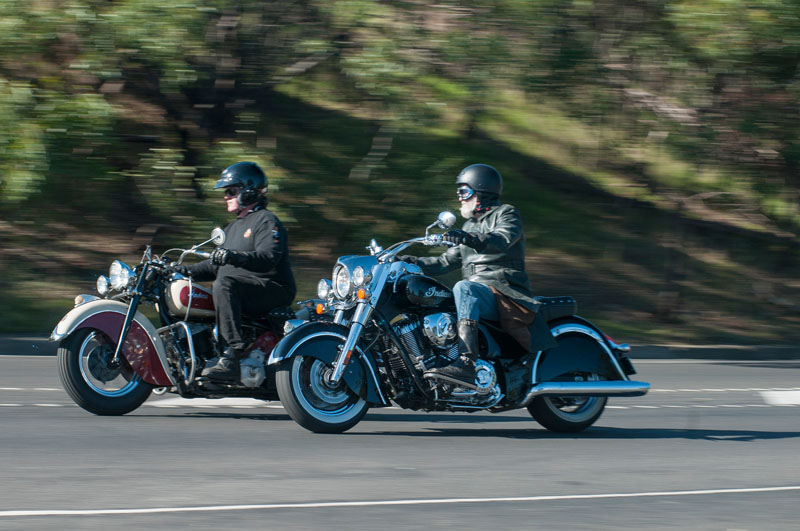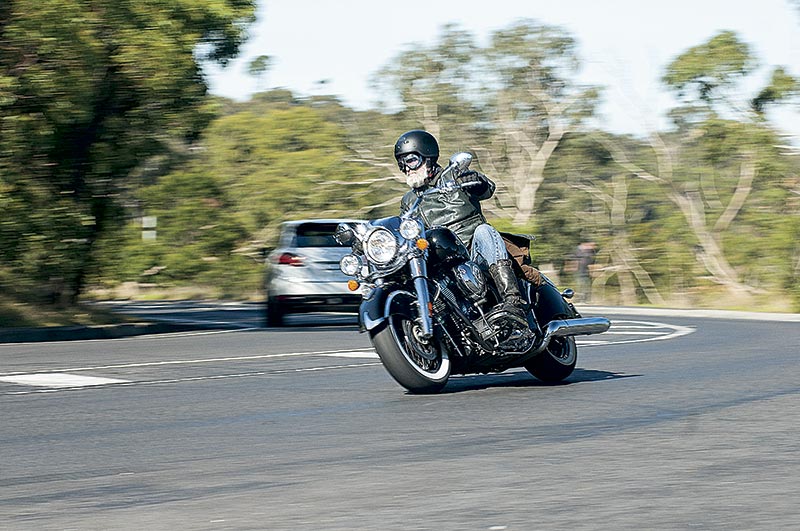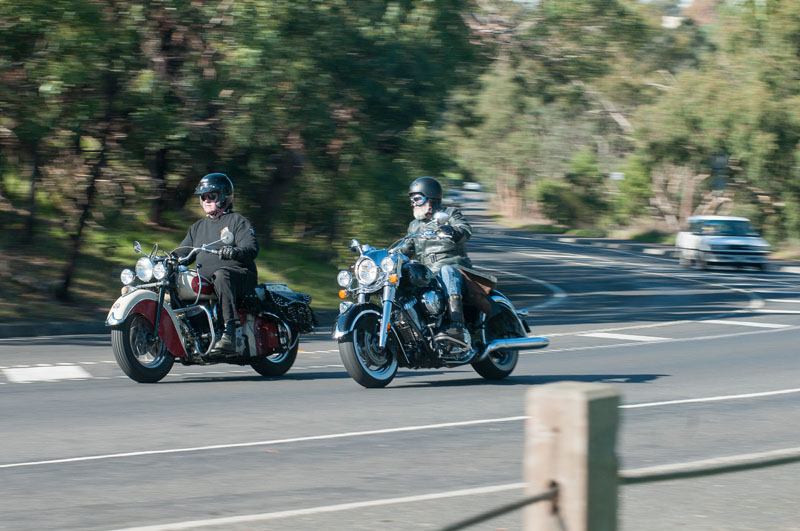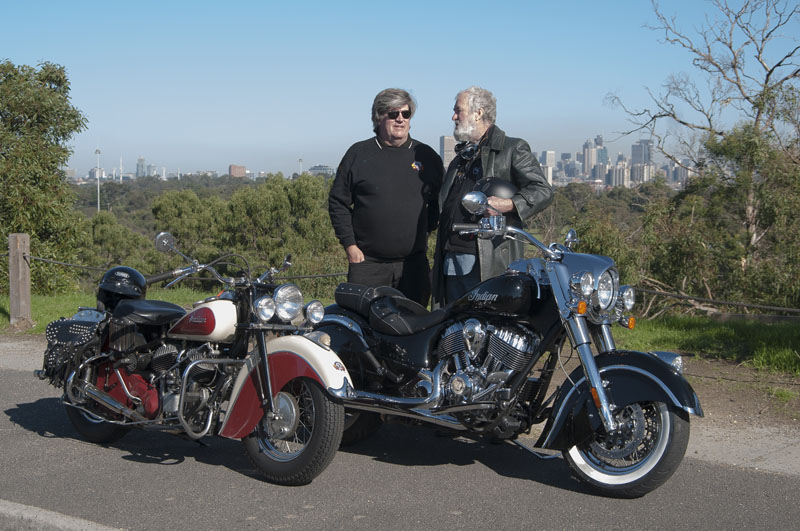Motorcycle Investor mag
Subscribe to our free email news

New vs Old - Polaris Indian 2014 vs Springfield 1947
(MT#288 updated May 2020)
by Guy 'Guido' Allen, pics by David McKenzie
Look for the video at the end.

The real thing?
Like others before it, Indian makes much of the connection to its history. But does it deliver?
It’s a strategy that’s been used before, but has its risks. That is effectively relaunching an historic marque, trading on the legacy and fame of the brand, while at the same time convincing everyone that the bikes are shiny, new and thoroughly modern.
What you’re trying to do is resuscitate the patient without their historical ‘baggage’, such as (typically for bikes) oil leaks and suspect reliability. It’s a bit like getting a second life, minus the convictions…
John Bloor’s Meriden-based Triumph Motorcycles went through it in the early 1990s and, two decades later, Polaris has pulled off the same trick with Indian Motorcycles.
Roughly a year after the dust from the worldwide launch has settled, it’s a good time to have a closer look at one of the core claims of Indian’s relaunch, which was “honouring our past, powering our future”.
In the ultra-long pre-launch excitement, Indian made a point of hitching its emotional and visual wagon to a 1947 model Chief, used in a lot of pre-publicity photos.
So, of course, we decided to do the bleeding obvious, which is grab our own 1947 Chief, running more or less in Sportsman trim, and put it alongside and example of the current Classic. This of course begs the question: can two bikes built 68 years apart have anything in common?

Let’s start with looks. The cynics among you will rightly point out that anyone can stick some deeply-valanced guards and a funny light on the front example and call it an Indian. In fact, the sweeping wheel covers and the war bonnet lamp on the front existed only for a very short part of the marque’s history, with the former introduced in 1940 and the latter in 1947. Both nevertheless have gained huge cultural traction and are now seen as compulsory for any big Chief. So tick two boxes.
Present someone with a pic of the 1947 and then the 2015 and they’ll have no trouble making the overall visual connection. Their profiles could be designed by the same person, who might have felt obliged to grudgingly update some of the detail over time.
It’s only when you get the two together that you are confronted with one fact: cruisers have got bigger over time. The tell-tale is in the wheelbase. A very long and low motorcycle for its day, the early machine has a wheelbase of 1540mm, compared to 1730 for the new chap. There’s also a significant weight difference, with the old fella claiming around 250 kilos, some 100 less than the new.
For many, though, the real development problem faced by Polaris was coming up with an engine that in any way resembled the sidevalve in the original. Ironically, the 1947 engine was very outdated even then – Harley-Davidson was a long way ahead in its OHV development at the time – but the look was important.
The engineers reckon the real devil was achieving the parallel pushrod tubes, distinctive to that powerplant. In the end the company settled on three cams driving two (overhead!) valves per cylinder in an air-cooled set-up. I reckon they got as close as they could with the visuals, even if the chrome is a little over the top. Plus, it’s a distinctive-looking powerplant – important in this market.
Both generations boast big engines for their day: 1200cc for the old and 1811cc for the new. Never say engineers don’t have a quirky sense of humour – both share a common stroke measurement of 113mm.
Look closely at the old Linkert carburetter on the ’47 and you’ll be forgiven for thinking it’s little more than a bit of crude pipe with a couple of adjustment knobs – a long way behind the digital injection system run today.

Not suprisingly, the new bike has about double the horsepower of the old (80 versus 40), while top speed is about 180 versus 130. Fuel consumption is greatly improved: up to 18km/lt on the new and more like 10km/lt (on a good day!) for the sidevalver.
You might wonder if Indian ever toyed with the idea of fitting a springer or girder-style front end, to mimic the old machine. I suspect they did, but the production costs are high and maintenance can be involved, so it’s not such a tragedy that they dodged that idea.
As for the ride, the 1947 uses a plunger rear end and sprung seat to good effect. It doesn’t handle as well as the new machine, but it’s remarkably comfortable and a hell of a lot better than many new cruisers. (Sprung saddles should make a comeback.)
As for braking, well forget any realistic comparison. The ABS-equipped disc combo on the new bike is as good as it gets in cruisers and very acceptable. The old machine was probably okay for 1947, but something of a challenge these days. Though it has an effective rear stopper, the front is woeful.
When it comes to ease of operation, the old machine might as well be from a different planet. With a three-speed hand-shift crash gearbox (no synchro), a rather clumsy foot clutch plus manual retard and advance on the twist grip opposite the throttle (you can get left or right throttle in these), and the pathetic brakes, you’re kept very busy around town.
As you can see, there are a lot of attributes that Indian wisely chose to avoid – in fact many wouldn’t pass current design laws.
But – and this is a big ‘but’ – there is one attribute which they clearly have in common. And that’s their ability to cruise. It’s no secret that a well set-up cruiser can be a simple and blissful companion out there on some gentle backroads where time and schedules count for little.
Funnily enough, the 1947 is capable of exactly the same trick. The reason I bought this one is I borrowed another for an event in the Snowy Mountains a couple of years ago and was genuinely staggered by how good it was at, err, well, cruising!
Find some rolling backroads and you could set the thing to 60mph (100km/h), and it feels strong and comfortable as you happily rumble towards the horizon.
Indian has, in my view, earned the right to draw a connection between the Springfield (old) and Spirit Lake (new) machines. Fortunately the designers had the good sense to leave a few attributes to rest in peace…
***

Making the connection
Indian Motorcycles Product Director Gary Gray (pictured above) made a point of highlighting the trouble the company went to when it came to informing the design of the new bikes with a knowledge of the old.
Here’s some of what he had to say, during the brand relaunch in 2013:
“To keep people focussed, we developed a three-part strategy for designing the bike.” The first (and most important in his view) was to honour their past. “When this bike came out, I didn’t want people to see it and say ‘what is that?’ I wanted them to see it and say, ‘that is an Indian motorcycle. These guys get it’.”
The second aspect was “just make it premium. There’s nothing lacking in terms of performance, or in terms of technology. In terms of chrome, there’s no bike that has as much as we have.
“The last element I think we had to bring is confidence.” He points out Polaris is forecast to be a US$3.8 billion company this year. “We’re a powersports company,” explains Gray, “We have all the operations, we have the infrastructure and plants now around the world. We go up against big brands, such as Honda, every single day.” He goes on to point out the company sells more off-road recreational vehicles, into the North American market, than anyone else.
On developing the bike itself: “We’ve got a huge brand history and that’s what we started with, really trying to understand the brand.
“Then a group of us went – I think it was May 2011 – on what we called the Indian Heritage Ride. We took off on motorcycles…and what we were doing was visiting dealerships, visited our factory, visited a guy in western Iowa that had about 25 Indians.”
The latter would delve into the shed, start one up – for example an early four – and offer them a ride. Gray talks of the fun and dramas of getting used to left-hand throttles, hand shifters and the like. It was “just really learning what an Indian motorcycle was – it was really important to us.
“A ton of research went into the project before we designed a bike.”
***

SPECS
2014 Indian Chief Classic
Type: 49 degree air-cooled OHV V-twin with pushrod-operated two valves per cylinder by three cams
Bore and Stroke: 101 x 113mm
Displacement: 1811cc
Compression ratio: 9.5:1
Fuel system: Electronic injection
TRANSMISSION
Type: 6-speed constant mesh
Final drive: Belt
CHASSIS & RUNNING GEAR
Frame type: Composite alloy
Front suspension: Conventional 46mm fork, no adjustment
Rear suspension: Monoshock, preload adjustment
Front brakes: 4-piston 300mm twin discs with ABS
Rear brake: 2-piston, 300mm disc with ABS
DIMENSIONS & CAPACITIES
Dry weight: 353kg
Seat height: 660mm
Fuel capacity: 20.8lt
PERFORMANCE
Max power: approx 80hp
Max torque: 16.5kg-m @ 3000rpm
OTHER STUFF
Price: $28,995 in the road
Test bike supplied by: Indian Motorcycle
Warranty: 24 months/unlimited km
1947 Indian Chief
Type: 42 degree air-cooled sidevalve V-twin with pushrod-operated two valves per cylinder by two cams
Bore and Stroke: 83 x 113mm
Displacement: 1200cc
Compression ratio: 6:1
Fuel system: Linkert carburettor
TRANSMISSION
Type: 3-speed with no synchro
Final drive: chain
CHASSIS & RUNNING GEAR
Frame type: steel tube
Front suspension: springer/girder fork
Rear suspension: dual plunger, plus sprung saddle
Front brakes: single-side drum
Rear brake: single-side drum
DIMENSIONS & CAPACITIES
Dry weight: approx. 250kg
Seat height: 740mm (without rider)
Fuel capacity: approx. 13lt
PERFORMANCE
Max power: approx. 40hp
Max torque: NA
OTHER STUFF
Price: @ $30-50,000 depending on condition
-------------------------------------------------
Produced by AllMoto abn 61 400 694 722
Privacy: we do not collect cookies or any other data.

Archives
Contact




